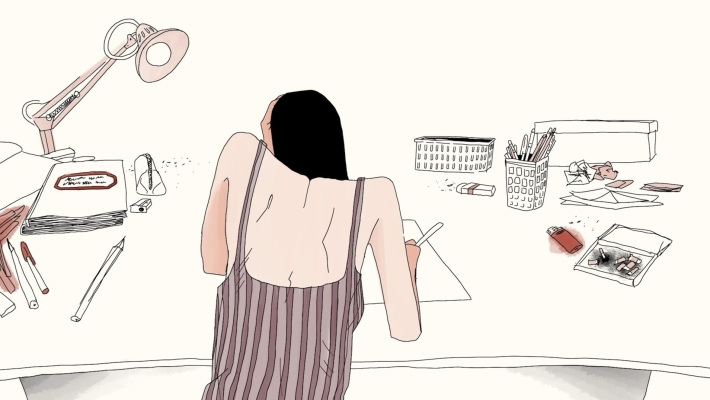
The 35th annual Animafest Zagreb featured diverse short animations united by introspective and concept-driven storytelling. Nowhere was this more apparent than in the festival’s Croatian Competition, where filmmakers turned inward, dissecting perceptions of reality, identity, and nature, highlighting the medium’s power to capture the inexplicable.
The winner of the Croatian Competition, ‘Psychonauts’ by Niko Radas, touches on topics related to maladjustment and personal identity. In a society where mental health diagnoses are handed out like loyalty cards, the film raises a bizarre question: What exactly happens to mental illness when it eventually leaves the body? Created in collaboration with patients from the University Psychiatry Hospital Vrapče in Zagreb, ‘Psychonauts’ envisions these disorders drifting through a post-apocalyptic limbo, endlessly searching for new hosts. There’s no dialogue, only an auto-tuned robotic voice singing side effects texts from medication instructions over an ethereal synth score. The surreal stop-motion odyssey opens with a round-faced puppet, staring at us with its frightened green eyes, and moves on to two other human figures in their sparse apartments. These rooms are a part of a larger, floating, fortress-like spaceship, with walls made of the packaging of prescription medications, eventually rotating out of the frame and into space. Perhaps that’s exactly where our intricate demons find their place after. ‘Psychonauts’ transforms the therapeutic experience into an oneiric journey through the mind that is equally cute and eerie. On a more important note, the film doesn’t just represent mental health, but goes to the very epicenter of the topic through input from people who confront these questions and dilemmas daily.

Pscyconauts
That oneiric vibe lingers in ‘How’, created by Marko Meštrović, a film that – like ‘Psychonauts’ – leans more towards and into a surreal, fractured logic. Constructed more like a thought process than a coherent plot, the film uses repetition and circularity of elements to convey existential contemplation. The cosmic abstractionism is then mixed with the evolutionary process of becoming homo sapiens. To heighten this psychedelic atmosphere, the film incorporates Mozart’s ‘Lacrimosa’. Although terribly overused, the requiem successfully mirrors the emotional weight ‘How’ carries. Occasional gusts of levity and absurd humor rise only to dissolve again into darkness. The film inhabits a liminal space between memory and forgetting, like something out of a dream.
A similar departure from conventional narrative occurs in Marta Margetić’s ‘Spine’ as the female body becomes both a canvas and a conduit for exploring somatic trauma. The key phrase here is softcore visceral. A nude female figure, rendered in stiff 2D motion, alternates through familiar yoga poses before eventually stretching to an inhuman degree. Eventually, sketched red lines crossing the female body, representing scratches of pain, combined with inhuman flexibility, evoke Junji Ito-esque unease as her body resembles rhythms that suggest internal rupture. There is nothing but the body, in the middle of a white void, similar to the sensation of pain itself, when the world dissolves and all that remains is the intensity of the sensation. This expands to a number of events that lead to ripping out her spine as if it were foreign to her body.
The recurring motif of the female body as a site overloaded with symbols finds its most maximalist expression in Maida Srabović’s ‘Fačuk’, arguably the most artistically versatile film of the program. Combining the surrealist iconography of Frida Kahlo and the expressive intensity of naïve art, the general idea is presented through the lenses of dogma, tradition, and inherited shame. Set in a God-fearing village, the film follows a young woman about to give birth to a fačuk – an illegitimate child considered a sin. Featuring dreamlike rituals and an infernal chorus of exaggerated villagers and spectral devils, Srabović’s directorial debut is especially striking in how confidently it renders psychological isolation in a collective and cult-like environment. Alongside its folkloric elements, the film reflects how Catholic moral codes shaped life in rural Croatia, where the female body was always under watch and never truly private. The uterus becomes a public institution in the village microcosm, constantly under surveillance. Despite the specific cultural setting, the film perfectly presents that no organ has been more politicized than the uterus, making the film universal. In this sense, ‘Fačuk’ and ‘Spine’ are connected, showing from opposite perspectives the way the female body absorbs, resists, and oftentimes violently rejects the pressures put on it.

‘Fačuk’
Taken as a whole, the Croatian Competition stood out as one of the festival’s highlights, showcasing a remarkable range of narratives and aesthetics. Most of these films didn’t aim to comfort; they aimed to reveal. Whether through uncanny humor, disturbing intimacy, or rebellion, the program proved once again that animation doesn’t illustrate reality, but interrogates it instead.
contributed by: Emel-Elizabeth Tuulik









